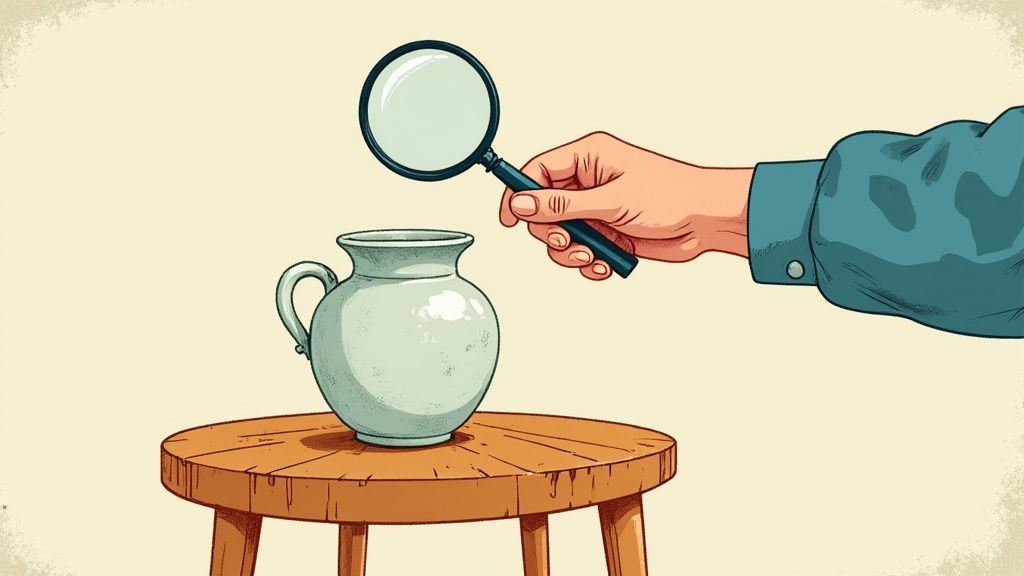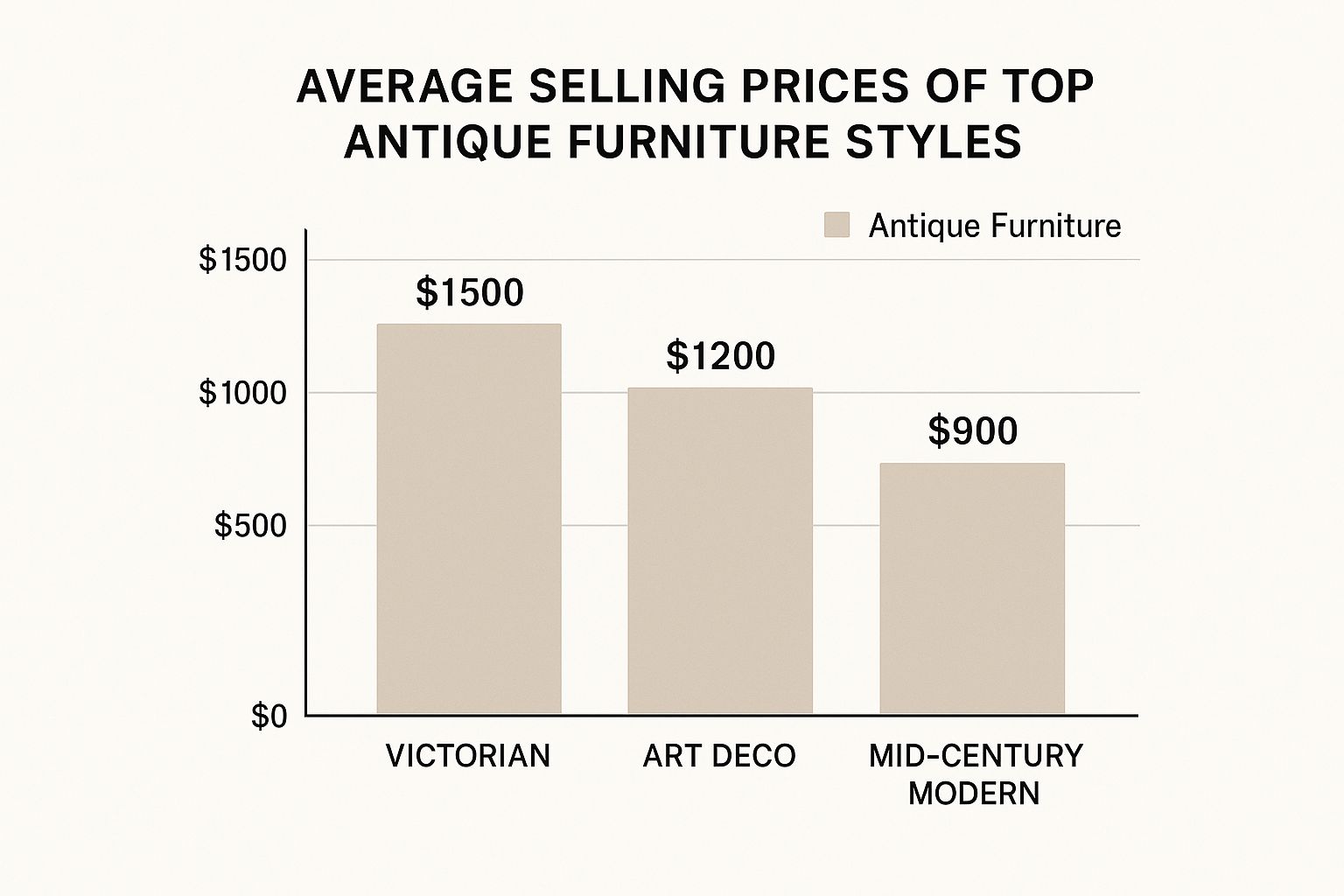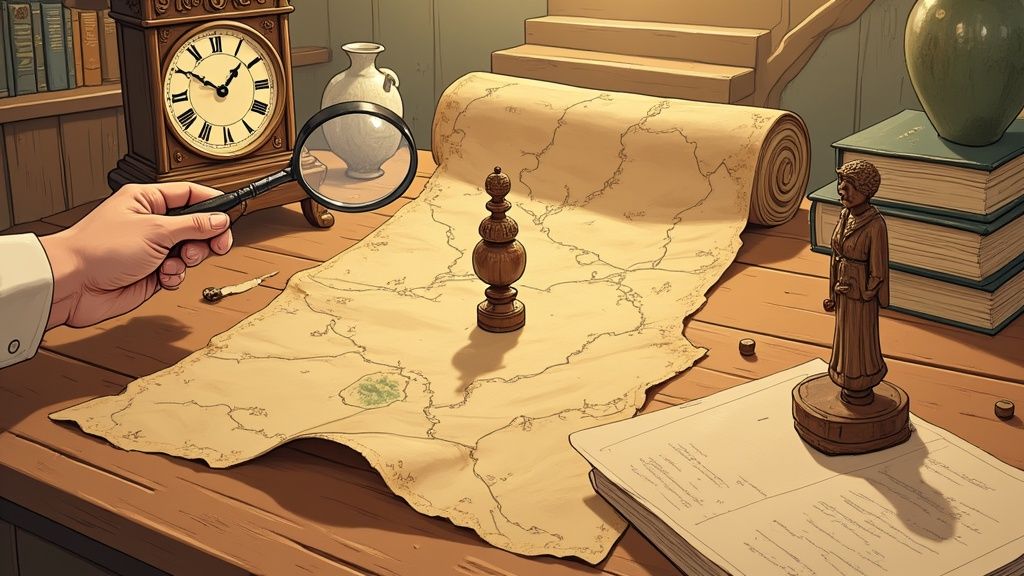Why Your Antique Price Guide Is Like a Treasure Map

Picture this: you’re at a garage sale, rummaging through dusty furniture. You spot a Chippendale chair, tagged with a $50 price sticker. Most people would see just another piece of old furniture. But you, with your trusty antique price guide, see something else entirely – the glint of potential treasure. That’s the power of knowing how to use these guides.
From Auction Catalogs to Sophisticated Systems
Antique price guides weren’t always so complex. They started as simple auction records, lists of what sold and for how much. But over time, they've evolved into sophisticated valuation systems. Now, they take into account a wide range of factors: maker’s marks, materials, historical context, and even the influence of changing styles and tastes.
Think of it like this: early guides were like basic roadmaps, giving you a general sense of direction. Modern guides are like GPS systems, using layers of information – historical data, current market activity, and expert analysis – to pinpoint the precise value of an antique.
Uncovering Hidden Value: The $3 Million Bowl
The power of these guides is perhaps best illustrated by the stories of incredible discoveries. There's the famous tale of the woman who bought a ceramic bowl at a yard sale for just $3. Using a price guide, she later discovered it was a rare 10th-century Chinese artifact. Its real value? A staggering $2.2 million.
This shows how price guides connect an object’s history to its monetary value in the current market. They’re not just about numbers; they're about understanding the story behind an object, the narrative that makes it valuable.
Beyond the Surface: The Power of Real-Time Data
Today's antique price guides incorporate real-time auction data, social media trends, and global market fluctuations. For example, the renewed interest in mid-century modern furniture, driven by online design communities, has dramatically changed the value of these pieces. A price guide from just a few years ago might be significantly out of date.
The global antique market itself shows the enduring value of these items. In 2024, it generated a remarkable USD 58.4 billion in revenue, making it the largest part of the broader second-hand collectibles market, a market worth hundreds of billions of dollars. Discover more insights into the antiques market here.
Navigating the Nuances of Value
Like a treasure map, an antique price guide offers clues that require careful interpretation. Learning to read these guides effectively is essential. It's about understanding the nuances of condition, provenance (an object's history of ownership), and market trends. Two seemingly identical items can have very different values based on subtle details that only a trained eye, with the help of a price guide, can discern.
The Hidden Factors That Make Identical Items Worth Thousands Apart

Imagine three furniture “flavors” on display: Victorian, Art Deco, and Mid-Century Modern. The infographic shows that Victorian pieces average the highest selling price, followed by Art Deco and then Mid-Century Modern. This is like choosing between gourmet truffles, handcrafted bonbons, and factory-made chocolates—each has its own appeal.
Now picture two Victorian chairs that look nearly identical, one listed at $500, the other at $5,500. What causes that gap? The answer lies in subtle clues—grain patterns, history, tiny signatures—that a good antique price guide decodes for you.
The Craftsmanship Conundrum: Hand-Carved vs. Machine-Made
One of the biggest drivers of value is craftsmanship. Think of a hand-knitted sweater versus one spun off an assembly line. A chair carved by hand in the 1800s carries the artisan’s personal touch—imperfections included—whereas a machine-made reproduction lacks that human story. In antiques, those slight tool marks and uneven curves are proof of a skilled hand at work, and they can boost a piece’s worth by a significant margin.
The Power of Provenance: Documentation and History
Next up is provenance, or an item’s backstory. A chair once owned by a notable figure, complete with bills of sale or letters, is like finding a signed first edition of a classic novel—it suddenly becomes a conversation piece. Documented lineage can add up to 35% more to the price tag, simply because collectors buy into the narrative as much as the object itself.
Maker’s Marks: More Than Just a Signature
Even small maker’s marks can be game-changers. Where a stamp sits or how it’s styled can pinpoint the workshop and year of creation. It’s akin to an artist’s evolving signature: early works might bear a different signature than later ones. Spotting that detail can turn a common piece into the holy grail of a collection, sometimes nudging prices up by 10–25%.
Beyond the Obvious: Repairs, Restorations, and Celebrity Connections
The condition story is nuanced. A discreet repair on a 200-year-old cabinet might be acceptable, even expected, whereas the same touch-up on a 50-year-old lamp could knock off a chunk of value. Similarly, celebrity ownership can be a double-edged sword: if a rock-star’s bold décor clashes with an antique’s style, that association might deter traditional buyers.
Understanding these finer points—craftsmanship, provenance, maker’s marks, condition, and celebrity ownership—is where a reliable antique price guide shines.
Key Valuation Factors and Their Impact on Antique Pricing
Below is a table that breaks down how each factor sways an antique’s price, with impact levels, typical price influence ranges, and real-world examples.
| Valuation Factor | Impact Level | Price Influence Range | Example Category |
|---|---|---|---|
| Craftsmanship | High | 20–40% premium | Furniture |
| Provenance | High | 15–35% premium | Decorative Arts |
| Maker’s Mark | Medium | 10–25% premium | Ceramics |
| Condition/Restorations | Medium | 5–15% reduction or increase | Metalwork |
| Celebrity Ownership | Low to Medium | 5–20% premium | Manuscripts |
This overview helps you see where to focus your attention when valuing an antique.
In summary, those thousands of dollars of difference often come down to minute details that only emerge when you dig deeper. Armed with a trusted price guide, you’ll learn to read an antique like a detective reads clues—and spot value where others see just “old stuff.”
Cracking the Code: How to Read Price Guides Like a Detective

Antique price guides. Are they just long lists of numbers, or something more? They're actually more like coded messages, full of clues waiting for a keen eye to decipher them. Once you understand their secrets, these guides become powerful tools for any collector. Let’s explore how to effectively interpret them and unlock your inner antique valuation detective.
Deciphering Condition Grades: From Mint to Rough
One of the most critical elements to grasp is the concept of condition grades. Think of it like assessing the quality of fruit at the market. A perfect, unblemished apple will naturally command a higher price than one with bruises. Similarly, the condition of an antique dramatically impacts its value.
These grades often run on a scale from mint condition (flawless) to poor (heavily damaged). The difference between mint and poor could mean a $2,000 antique versus a $200 one. A small chip on a delicate porcelain figurine might drastically decrease its value, while the same imperfection on a rustic, weathered piece might barely register.
The Price Puzzle: Auction vs. Dealer vs. Insurance
Price guides typically list different types of values, each with its own unique meaning. You'll see auction prices, which reflect the actual selling price in a competitive bidding environment. Then there are dealer prices, representing the price a retailer might charge in their shop. Finally, there are insurance values, centered on the cost of replacing the item, often exceeding its market value.
Knowing which value is relevant to your situation – buying, selling, or insuring – is essential. If you're buying, auction prices provide a realistic benchmark. If you're insuring, the replacement value is the crucial figure.
Cross-Referencing: Spotting Market Discrepancies
Just like a detective cross-checks witness testimonies, a savvy collector consults multiple price guides. Why? Because comparing prices across different sources can uncover valuable market discrepancies – those hidden gems undervalued in one guide and overpriced in another.
Perhaps one guide hasn't caught up to a recent surge in demand for a specific type of antique. That creates a buying opportunity! Or maybe a consistent price drop across multiple guides signals a cooling market. These price fluctuations are your clues, pointing you towards smart collecting choices.
Interestingly, Europe holds a significant 36.89% revenue share in the global collectibles market as of 2023. This highlights the interconnectedness of the antique world and the value of understanding international trends. Discover more insights on the collectibles market. Want to further refine your skills? Check out this resource on identifying antiques.
Reading Between the Lines: Market Trends and Subtle Language
Numbers aren't the whole story. The descriptive language within a guide can be just as revealing. Pay attention to phrases like "increasingly popular," "rarely seen," or "declining interest." These are your market trend indicators, whispering secrets about which categories are heating up or cooling down. Like a detective analyzing body language, learning to read these subtle cues gives you a distinct advantage.
Decoding Price Ranges: Confidence and Volatility
Finally, understand the significance of the price range offered in a guide. The gap between the low and high estimates provides insight into market confidence and price volatility. A narrow range, like $100-$200, suggests a stable market with consistent pricing. A wider spread, such as $100-$500, indicates more uncertainty or variability. This spread is as important as the average price when evaluating potential risks and rewards associated with different antique categories.
How Digital Tools Are Revolutionizing Antique Pricing
Remember the days when figuring out the value of an antique meant hours in dusty libraries and countless phone calls? The antique world has come a long way. Now, information is just a few clicks away. Online auction sites, social media, and specialized databases have completely changed how we research and understand antique prices. This makes things more transparent, but also presents new challenges, requiring collectors to combine traditional price guides with the latest digital info.
The Rise of Online Auctions and Real-Time Data
Online auction platforms like LiveAuctioneers give us a peek into current market values. Think of it like a virtual marketplace where you can see what items are actually selling for.
This screenshot shows a variety of items, from vintage jewelry to antique furniture, all available on LiveAuctioneers. Using the search bar and filters, collectors can quickly find similar pieces and see their recent selling prices. This real-time data adds another layer to the information found in printed price guides, giving a sense of market trends as they happen. Plus, the sheer volume of items online often goes beyond what's available in a local antique shop.
Social Media's Unexpected Influence
Believe it or not, social media also plays a big role in the antique world. Picture collectors sharing their latest finds on Instagram and connecting with experts. These online communities can bring unknown makers to light, revive interest in forgotten styles, and even rewrite sections of antique price guides. For example, mid-century pottery, which was once largely ignored, saw a huge surge in popularity after trending on design blogs. This led to a dramatic price increase. Online sales in the art and antiques market reached about USD 11.8 billion in 2023, a 7% jump from the year before. This really shows the growing power of digital platforms. Discover more insights into online art and antique sales here.
Navigating the Digital Landscape
While all this online information is great, it also has its downsides. The sheer amount of data can be overwhelming, making it tough to separate reliable information from misleading listings or inflated prices. Smart collectors learn to compare information from different sources, verify authenticity using online databases, and connect with trusted experts in online communities. They know digital tools are powerful, but they also know they need to use them carefully and critically. By combining traditional antique price guides with carefully checked digital resources, collectors can confidently navigate the ever-changing antique market and make informed decisions.
Tailored Strategies for Every Type of Collector

Your journey collecting antiques is a personal one. How you use a price guide will also be unique to you. Whether you're buying your very first piece or managing a large collection, let's explore how price guides can help you meet your collecting goals.
Starting Out: Building Confidence
For a new collector, a price guide is like a map to unfamiliar terrain. It helps you avoid common mistakes, such as overpaying for something readily available or overlooking a hidden gem. Learning to discern a realistic price from a deal that's "too good to be true" is an essential skill. A price guide is a helpful tool as you gain experience and become a more confident collector. Everyone starts somewhere!
You might be interested in: Identifying antique furniture.
Leveling Up: Timing the Market
As your experience grows, an antique price guide becomes a strategic tool. More seasoned collectors use guides to understand the ebb and flow of the market – much like understanding the tides. This helps you know when to buy low and when to consider selling. Price guides can also help you identify undervalued categories ripe for growth. Think of it as finding a promising neighborhood before property values skyrocket. It involves looking beyond the obvious and researching trends within specific antique types.
The Serious Collector: Portfolio Management
For the established collector, a price guide becomes important for managing your collection, insurance, and even estate planning. Think of it like managing a financial portfolio, but with tangible assets that often hold sentimental value, too. Price guides offer a way to track the overall value of your collection for insurance purposes. They also provide necessary documentation for estate planning, ensuring your collection’s future.
This table summarizes how collectors at different experience levels can use price guides effectively.
Collector Strategy Guide by Experience Level
Tailored approaches for using price guides effectively based on collecting experience and investment goals
| Collector Level | Primary Focus | Key Strategies | Common Pitfalls to Avoid |
|---|---|---|---|
| Beginner | Building basic knowledge and confidence | Learning to identify items and understand general price ranges; Avoiding overpaying for common items | Trusting deals that seem too good to be true; Mistaking reproductions for genuine antiques |
| Intermediate | Refining knowledge and timing the market | Identifying undervalued categories; Recognizing market trends and cycles | Overestimating the value of items based on sentimental attachment; Chasing short-term market fluctuations |
| Advanced | Portfolio management and long-term growth | Tracking collection value for insurance and estate purposes; Researching and investing in rare or historically significant items | Neglecting proper documentation and record-keeping; Overdiversifying without a clear collecting focus |
The table demonstrates how a collector's focus and strategies evolve alongside their experience.
Motivation Matters: Passion vs. Investment
Your motivations also influence how you use a price guide. Are you driven by passion, or are you looking at your collection as an investment? Imagine two collectors: one loves Art Deco glass for its beauty and design, while the other sees it as a financial asset. They'll approach price guides differently. The investor will concentrate on market trends and potential for appreciation. The passion-driven collector will prioritize rarity and historical significance.
Building a Collection You'll Treasure
Ultimately, your collection should be a reflection of your interests. Antique price guides provide the knowledge you need to make smart decisions. They help you build a collection you will truly appreciate, whether your focus is finding affordable pieces you love or building a legacy for generations to come. Using a price guide wisely helps you build a collection that’s both personally satisfying and potentially valuable.
Reading Between the Lines: What Price Guides Can't Tell You
Antique price guides are invaluable resources. They offer a helpful glimpse into the general value of items, like figuring out a starting point for that antique dresser you inherited or a ballpark figure for a vintage necklace. But like any snapshot, they capture only a moment in time. Price guides provide valuable data, but they don’t always reflect the real-world market forces that can dramatically shift an item’s worth.
Think of it like checking the weather forecast. The temperature reading is useful, but it doesn’t tell you the whole story. What about the wind chill? That’s where this section comes in. We'll explore those “wind chill” factors—the often-unpredictable cultural currents a smart collector needs to navigate.
The Winds of Change: Culture and Trends
Imagine heavy, ornate Victorian furniture. For decades, these pieces were prized possessions, highly sought after by collectors. Then, as the minimalism movement gained traction, these once-treasured items lost their luster and became less desirable. Price guides couldn't instantly reflect this dramatic shift.
This example highlights how societal changes, emerging lifestyle trends, and even fleeting cultural moments create ripples in the antique market—ripples that price guides can’t always anticipate or quantify.
For example, the rise of platforms like Instagram unexpectedly propelled certain pottery styles into the limelight. Suddenly, a niche interest blossomed into a widespread craze, sending prices skyrocketing. A price guide from before this social media surge would be completely out of touch with current values. This kind of rapid change can impact many areas of collecting, such as antique jewelry. You might find this interesting: learning more about identifying antique jewelry.
Regional Flavors and Seasonal Shifts
Just like fashion trends vary from city to city, antique values experience regional differences. A certain style of glassware might be highly collectible in the Northeast but gather dust in the Southwest.
Similarly, think about how seasons influence consumer behavior. Holiday-themed items see a predictable price spike during their relevant season, then decrease again. These are the subtle, nuanced market behaviors that standard price guides often miss.
The Economic Rollercoaster
The economy also plays a significant role. During a recession, demand for luxury antiques might drop while more affordable collectibles maintain, or even increase, in popularity. A booming economy, on the other hand, can create a surge in demand for high-end items. These economic cycles present both challenges and exciting opportunities for collectors, and they must be considered alongside price guide information.
Combining Data with Cultural Awareness
The key takeaway here is that antique price guides are a starting point, not the final word. Smart collectors use price guides as one tool among many, combining data with a keen awareness of cultural trends, regional preferences, and the ebb and flow of the economy. They aren't just looking at numbers; they’re understanding the story those numbers tell. This ability to “read between the lines” allows them to anticipate market shifts, spot emerging trends, and ultimately, make more informed decisions that blend financial savvy with a passion for the past.
Your Action Plan for Price Guide Mastery
Now, let's turn all this information into a practical system for collecting with confidence. Imagine having a clear path for evaluating any antique, along with a way to track your collecting journey. That's what we'll build here.
Building Your Price Guide Toolkit
Think of this like assembling your detective's toolkit. You'll need a mix of traditional and modern tools:
Physical Antique Price Guides: These are your core resources. Start with broad guides, then add specialized guides focused on your interests, like furniture, ceramics, or jewelry.
Digital Resources: Online auction platforms like LiveAuctioneers show real-time market data – what items are actually selling for right now. Online databases and social media groups can help you identify makers, verify authenticity, and spot new trends.
Personal Price Tracking System: Picture a simple spreadsheet or notebook where you record items you're interested in, along with prices from different guides and auction results. This helps you notice pricing patterns, see how values change over time, and make smarter purchases.
Your Antique Evaluation Checklist
Before buying any antique, use this checklist:
Identify the Item: Use your resources to precisely figure out what you're looking at. Is it a genuine antique, a reproduction, or something else entirely?
Assess Condition: Remember our earlier discussion on condition? Minor flaws are expected in older items, but serious damage greatly affects value. A scratch on a vintage lamp is usually okay, but a cracked base changes everything.
Research Provenance: If you can, trace the item's history of ownership. Documentation, like old receipts or letters, can significantly boost its value. It's like finding a signed first edition of a book – that personal touch adds a premium.
Check Maker's Marks: These marks often tell you when and where a piece was made. Think of it like an artist's signature, revealing the piece's origin and sometimes increasing its value.
Compare Prices: Use your price tracking system to compare prices from various sources. This can help you find undervalued items or discover developing trends.
Building Relationships and Refining Your Strategy
Collecting isn't just about research; it's about connecting with fellow enthusiasts:
Connect with Reputable Dealers: Knowledgeable dealers are incredible resources. They offer expertise, advice, and sometimes access to items not readily available. It's like having a mentor in your chosen collecting field.
Create a Collecting Strategy: Define your focus. Do you love a specific period, style, or maker? Or are you more interested in investment potential? Knowing this will guide your decisions and prevent impulsive purchases.
Continuously Learn: The antiques world is dynamic. Keep learning about market trends, new authentication methods, and emerging collecting areas to ensure your choices are always well-informed.
